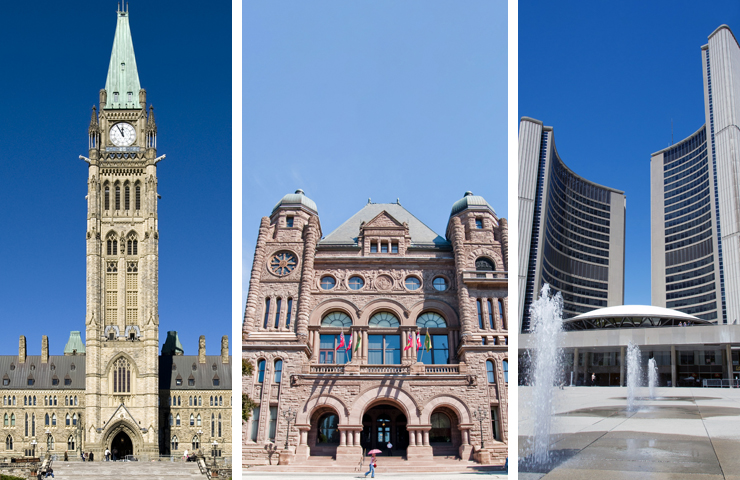Elementary Lessons
)
Title
Levels of Government
Guiding Question
Why is it important to know how government is structured in Canada? How does government affect me?
OVERVIEW
Governments make decisions and pass legislation that impacts the lives of citizens. Canada has several levels of government, each with its own elected representatives and areas of responsibility.
In this unit, students first explore roles and responsibilities in their school community and then within the levels of government in Canada. Students reflect on all the ways the different levels of government affect their lives and then analyze which level is most important to them. In the Consolidation activity, students identify an issue that matters to them and write a letter to the most appropriate elected representative.
LEARNING GOALS
We are learning to:
- develop an understanding of how government is structured in Canada (Concepts of Thinking – Significance);
- develop an understanding of how the levels of government work together and influence Canadian society (Concepts of Thinking Interrelationships);
- learn how political institutions affect our lives (Citizenship Education Framework – Structures);
- analyze the short-term and long-term impact of a civic issue (Concepts of Thinking – Significance).
SUCCESS CRITERIA
I CAN…
- identify the roles and responsibilities associated with the different levels of government in Canada (significance);
- describe how governments work together and influence society (interrelationships);
- explain how government affects me directly;
- analyze the short-term and long-term impact of an issue that matters to me (significance).
CURRICULUM LINKS
Social Studies Gr. 5 B2, B3, B2.1, B3.2
Oral Communication 2, 2.3
Writing 1, 1.4, 1.5
Media Literacy 3, 3.2
MINDS ON
Who is responsible for what?
1. Explain the idea that within schools, and in any community, there is a division of responsibilities. Different issues are handled by different people.
2. Ask students who they would go to in the following scenarios.
- Someone stole money from your pockets during gym class
- Your cell phone that you left in your locker is now gone
- A bucket of water spilled in the hallway
- You had a question about your writing assignment
- You were feeling sick and wanted to go home
- You wanted to help with the school dance or musical concert
- You wanted to try out for the basketball team
- You were called an inappropriate name on the bus to school
- A friend posted a picture of you to social media that is embarrassing and you do not want it posted
3. Why is it important to know who is responsible for what in your school or community?
ACTION
1. Using the images in the accompanying slide deck (Who am I?), gauge student’s current knowledge about government and politics in Canada. Images include current Prime Minister Justin Trudeau, Premier Doug Ford, Governor General Julie Payette, parliament buildings and the Ontario Legislative Assembly, plus other non-political figures. This can be completed through class discussion or have students jot down their answers on paper.
Afterwards, invite students to share what they know about how government is organized in Canada.
2. Using the accompanying slide deck and/or the ‘Levels of Government in Canada’ video (2:27 min) review the levels of government in Canada. Suggested questions to cover during instruction and discussion:
- Why is government in Canada divided into different levels?
- What are the levels of government in Canada (federal, provincial, municipal and Indigenous governments)?
- What is the name of the elected representative at each level?
- What is the name of the leader at each level? How are they chosen?
Teacher note: Write student answers on the board or chart paper and add a printed photo for each leader and representative for future reference.
3. Review the concept that each level of government has its own set of responsibilities. Explain the idea that the level of government closest to the issue governs it (i.e., the federal government is responsible for international trade, not municipal governments). Provide some examples of responsibilities and ask students to guess which level of government is responsible for it. You could
use examples from Activity 4.1.
4. Using a ‘Think-Pair-Share’ strategy, have students complete Activity 4.1. Give students enough time to answer the questions, share with a partner and then take it up as a class.
- Step 1: Highlight or circle all the government areas that affect your life. Provide specific details for three areas. For example, transportation: driver licensing, highways.
- Step 2: Which level of government do you think influences your life the most? Explain your choice. Do you think this will change when you are 30 years old?
- Step 3: Write down three examples of responsibilities where different levels of government have to work together on an issue.
Teacher note: Provide an example for Step 3, such as natural resources (federal and provincial).
Alternative Activity:
Ask students to keep a ‘diary’ or create a comic strip of their actions throughout the day. For each activity, ask students to identify the level of government and area of responsibility connected to the activity.
CONSOLIDATION
Have a brief closing discussion about government in Canada, or ask students to write a reflection on one or more of the following questions:
- Is government important? Why or why not?
- Why is it important to know which level of government is responsible for what?
- What issue in your community concerns you the most? Find out which level or levels of government are responsible for this matter and write to your appropriate local representative (it could be more than one). The letter should identify the short-term and long-term impact of the issue on the community, province or country.
TIPS FOR TEACHERS
- When discussing big concepts like elected representatives and levels of government, create classroom visuals with photos or images to give students a quick reference point throughout the unit or Student Vote process.